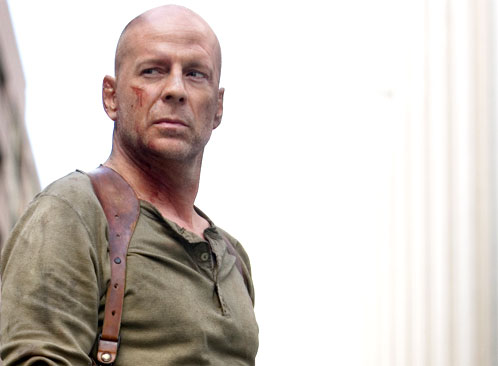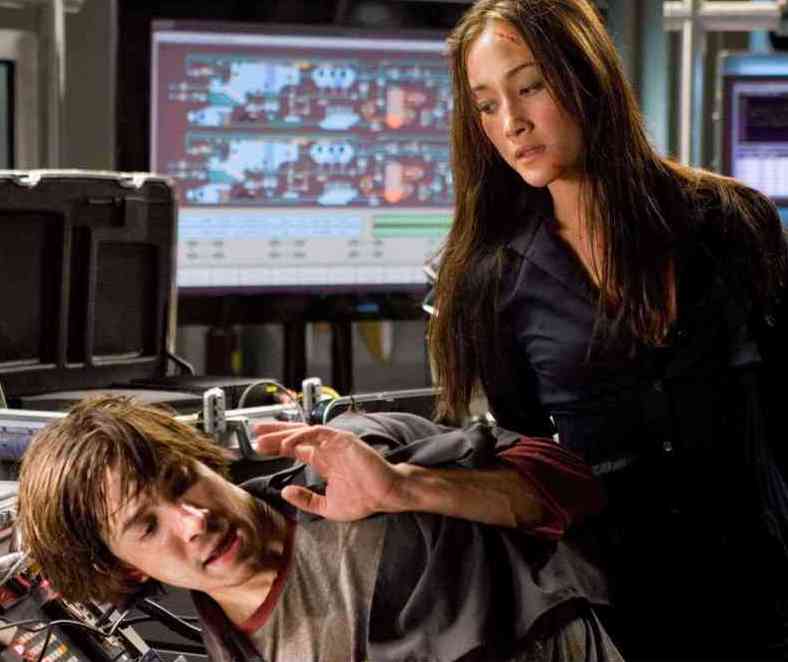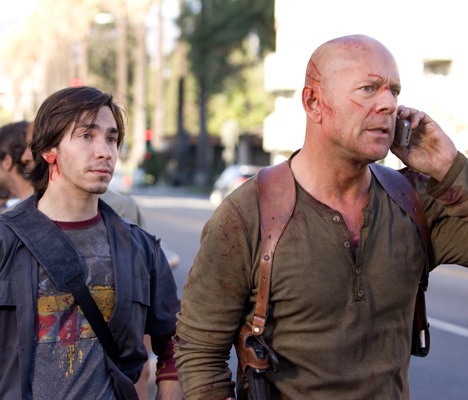 I find Len Wiseman’s Live Free or Die Hard, a.k.a. Die Hard 4 or “Die Hard in the Chesapeake,” a difficult movie to review (which is perhaps why it’s taken me an extra week to spend any time on it.) As a long-awaited fourth installment in the Increasingly Unlikely Trials of John McClane, I’d say it’s probably better than Die Harder (about which I only really remember Fred Thompson as an ATC exec) and Die Hard 3 (which brings to mind Samuel L. Jackson in Malcolm X glasses doing jug-of-water problems), and it’s a considerably more enjoyable movie than I expected from the director of Underworld. But it also doesn’t make much sense, it traffics in action-movie cliche, most of its boldest setpieces were telegraphed in the previews, and it doesn’t hold a candle to the still-quite-impressive first film, which ranks deservedly high in the Actioner Hall of Fame. In short…well, it is what it is. I was intermittently amused and diverted by about half of Live Free or Die Hard, restless and somewhat bored by the other half. Bruce Willis has always been an easy actor to root for, and it’s definitely fun to see him back in the saddle as America’s favorite Working-Class Hero, but in the end I thought this Die Hard didn’t really pay the nostalgic dividends of, say, Sly Stallone’s recent return as Rocky Balboa. Willis doesn’t embarrass his franchise by any means, but he doesn’t really add much of note here either.
I find Len Wiseman’s Live Free or Die Hard, a.k.a. Die Hard 4 or “Die Hard in the Chesapeake,” a difficult movie to review (which is perhaps why it’s taken me an extra week to spend any time on it.) As a long-awaited fourth installment in the Increasingly Unlikely Trials of John McClane, I’d say it’s probably better than Die Harder (about which I only really remember Fred Thompson as an ATC exec) and Die Hard 3 (which brings to mind Samuel L. Jackson in Malcolm X glasses doing jug-of-water problems), and it’s a considerably more enjoyable movie than I expected from the director of Underworld. But it also doesn’t make much sense, it traffics in action-movie cliche, most of its boldest setpieces were telegraphed in the previews, and it doesn’t hold a candle to the still-quite-impressive first film, which ranks deservedly high in the Actioner Hall of Fame. In short…well, it is what it is. I was intermittently amused and diverted by about half of Live Free or Die Hard, restless and somewhat bored by the other half. Bruce Willis has always been an easy actor to root for, and it’s definitely fun to see him back in the saddle as America’s favorite Working-Class Hero, but in the end I thought this Die Hard didn’t really pay the nostalgic dividends of, say, Sly Stallone’s recent return as Rocky Balboa. Willis doesn’t embarrass his franchise by any means, but he doesn’t really add much of note here either.
 So what’s the doomsday scenario this time? Well, as the movie begins, we watch various teenage computer hackers, geeks, and webheads out of Fanboy Central Casting report in to the comely villainess Mai (Maggie Q) with their various h4xor pet projects, then — thanks to their sabotaged PCs — get rubbed out in an explosive fireball of Playstation parts, computer cables, Red Bull cans, and collectible figurines. Escaping this awful fate — but only barely — is Mac Guy (Justin Long), who was fortunate enough to have had NYPD Det. John McClane in the nearby Rutgers area, troubling potential suitors to his daughter (Mary Elizabeth Winstead), and asked by the usual consortium of concerned government NSA-types to pick the kid up. Soon, McClane and Mac Guy are on a road trip to DC to see these aggrieved Feds when the real cybermachinations begin: all traffic lights go green, all fire alarms go off, all stocks plunge. And, we come to discover, pulling the strings is an even more aggrieved Fed, one Thomas Gabriel (Tim Olyphant), a cyberterrorism expert whose Richard Clarke act got him fired and buried by the blase powers-that-be. Now a private citizen, he’s out to make them, and all America pay, unless McClane can work his analog mojo to stop Gabriel’s digital devastation…
So what’s the doomsday scenario this time? Well, as the movie begins, we watch various teenage computer hackers, geeks, and webheads out of Fanboy Central Casting report in to the comely villainess Mai (Maggie Q) with their various h4xor pet projects, then — thanks to their sabotaged PCs — get rubbed out in an explosive fireball of Playstation parts, computer cables, Red Bull cans, and collectible figurines. Escaping this awful fate — but only barely — is Mac Guy (Justin Long), who was fortunate enough to have had NYPD Det. John McClane in the nearby Rutgers area, troubling potential suitors to his daughter (Mary Elizabeth Winstead), and asked by the usual consortium of concerned government NSA-types to pick the kid up. Soon, McClane and Mac Guy are on a road trip to DC to see these aggrieved Feds when the real cybermachinations begin: all traffic lights go green, all fire alarms go off, all stocks plunge. And, we come to discover, pulling the strings is an even more aggrieved Fed, one Thomas Gabriel (Tim Olyphant), a cyberterrorism expert whose Richard Clarke act got him fired and buried by the blase powers-that-be. Now a private citizen, he’s out to make them, and all America pay, unless McClane can work his analog mojo to stop Gabriel’s digital devastation…
 Uh, Mac Guy? McClane’s all-grown-up teenage daughter? And yet, one of the bigger surprises in this otherwise regular-as-clockwork movie is how well it sidesteps what at first look to be really obvious pitfalls. For example, sidekick Justin Long doesn’t come off half as irritating as you might expect, and in fact acquits himself rather well. And while Winstead is given some predictably schlocky “Baby Badass” moments — a la Katherine Heigl in Under Siege 2 — they’re thankfully few and far between. (As for the baddies, Olyphant’s Seth Bullock seethe is put to good use here, but he’s still no Hans Gruber…although I think I’ll take Maggie Q and a parkour henchman or two (a la Casino Royale) over Alexander Godunov.) And, for his part, Bruce Willis is still convincingly tough, crazy, and disgruntled as the man of the hour despite himself….one hopes Harrison Ford holds up as well for his upcoming stint in Indy IV.
Uh, Mac Guy? McClane’s all-grown-up teenage daughter? And yet, one of the bigger surprises in this otherwise regular-as-clockwork movie is how well it sidesteps what at first look to be really obvious pitfalls. For example, sidekick Justin Long doesn’t come off half as irritating as you might expect, and in fact acquits himself rather well. And while Winstead is given some predictably schlocky “Baby Badass” moments — a la Katherine Heigl in Under Siege 2 — they’re thankfully few and far between. (As for the baddies, Olyphant’s Seth Bullock seethe is put to good use here, but he’s still no Hans Gruber…although I think I’ll take Maggie Q and a parkour henchman or two (a la Casino Royale) over Alexander Godunov.) And, for his part, Bruce Willis is still convincingly tough, crazy, and disgruntled as the man of the hour despite himself….one hopes Harrison Ford holds up as well for his upcoming stint in Indy IV.
Nevertheless, what Live Free or Die Hard is really missing is the narrative economy of the first film, which all took place within the increasingly claustrophobic confines of the Nakatomi Building (thus spurring the “Die Hard on a *blank*” genre in the first place.) Instead, this movie is sprawled out across the mid-Atlantic, with McClane & co. actually driving off to West Virginia and back at one point. Perhaps as a result, the tension in Live Free or Die Hard often goes completely slack, as McClane and Mac Guy have nothing to do but trade clunky exposition or thinly veiled movie-message pablum while driving from place to place. And unlike in the first movie, when, say, McClane is forced to do unsavory things like pull pieces of broken glass out of his torn, bloodied feet, there’s never much sense of any real danger or menace in this film. Perhaps it’s progress, I suppose, but dying hard here doesn’t seem half as troubling as it used to.
